Forest Loss Drivers and Landscape Pressures in a Northern Moroccan Protected Areas’ Network: Introducing a Novel Approach for Conservation Effectiveness Assessment
Abstract
1. Introduction
2. Materials and Methods
2.1. Study Area
- Parks
- Continental SBEIs
- Coastal SBEIs
2.2. Methods and Data Sources
2.2.1. Analysis of Deforestation Drivers
2.2.2. Analysis of Landscape Pressures
2.2.3. Assessing PAs’ Conservation Effectiveness
- Cumulative Effect Index
- Bivariate Analysis
- -
- Spatial units with high CEI values surrounded by spatial units with high nearest distance to PAs’ network values; we refer to these units as HH associations;
- -
- Spatial units with high CEI values surrounded by spatial units with low nearest distance to PAs’ network values, i.e., HL associations;
- -
- Spatial units with low CEI values surrounded by spatial units with low nearest distance to PA’s network values, i.e., LL associations;
- -
- Spatial units with low CEI values surrounded by spatial units with high nearest distance to PAs network values, i.e., LH associations;
- -
- Units with non-significant (NS) values (units whose values and the values of their neighbors are close to the average of the total sample).
- PAs’ Zoning and Conservation Ratios
- Classifying PAs and defining conservation typologies
3. Results
3.1. Analysis of Deforestation Drivers
3.2. Analysis of Landscape Pressures
3.3. PAs’ Conservation Effectiveness Assessment
3.3.1. Cumulative Effect Index
3.3.2. Bivariate Analysis and PAs’ Zoning
3.3.3. Conservation Effectiveness Typologies
4. Discussion
4.1. Analysis of Deforestation Drivers
4.2. Analysis of Landscape Pressures
4.3. PAs’ Conservation Effectiveness Assessment
- Step 1: Identification of major pressures
- Step 2: Data Collection and Preliminary Analyses
- Step 3: Calculation of the Cumulative Effect Index (CEI)
- Step 4: Bivariate analysis
- Step 5: Zoning identification
- Step 6: Diagram of conservation effectiveness typologies
5. Conclusions
Author Contributions
Funding
Data Availability Statement
Acknowledgments
Conflicts of Interest
References
- Ervin, J. Making Protected Areas Relevant: A Guide to Integrating Protected Areas into Wider Landscapes, Seascapes, and Sectoral Plans and Strategies; Secretariat of the Convention on Biological Diversity: Montreal, QC, Canada, 2010. [Google Scholar]
- UNDP (United Nations Development Programme). Creating a Nature Positive Future: The Contribution of Protected Areas and Other Effective Area-Based Conservation Measures; UNDP: New York, NY, USA, 2021. [Google Scholar]
- Benabid, A. Flore et Écosystèmes du Maroc: Évaluation et Préservation de la Biodiversité; Ibis Presses: Paris, France, 2000; ISBN 978-2-910728-13-7. [Google Scholar]
- ONEM Observatoire National de l’Environnement du Maroc-Ministère de L’Aménagement du Territoire, de L’Urbanisme, de L’Habitat et de L’Environnement Departement de l’Environnement: Etude Nationale sur la Biodiversité-Rapport de Synthèse. Available online: https://inau.ac.ma/binau/index.php?lvl=notice_display&id=786 (accessed on 3 February 2024).
- MEMEE (Ministère de l’Énergie, des Mines, de l’Eau et de l’Environnement). Stratégie et Plan d’Action National de la Biodiversité; MEMEE: Rabat, Morocco, 2014. [Google Scholar]
- ANEF Gestion de la Biodiversité. Agence Nationale des Eaux et Forêts-Quartier Administratif, Rabat—Chellah. Available online: http://www.eauxetforets.gov.ma/Biodiversite/GestionBiodiversite/Pages/Gestion-Biodiversite.aspx (accessed on 4 February 2024).
- MEMEE. État et Avenir de l’Environnement de la Région Tanger—Tétouan: SYNTHÈSE POUR LES DÉCIDEURS: 2013; Ministère de l’Energie, des Mines, de l’Eau et de l’Environnement-Département de l’Environnement: Rabat, Morocco; Observatoire Régional de l’Environnement et du Développement Durable de la Région Tanger-Tétouan: Tanger, Morocco, 2013. [Google Scholar]
- Tellier, J.L.; Debbi, F. La Mobilite Urbaine dans L’Agglomeration de Tanger: Evolutions dt Perspectives; Sophia Antipolis Regional Activity Center: Sophia Antipolis, France, 2009. [Google Scholar]
- Boubekraoui, H.; Maouni, Y.; Ghallab, A.; Draoui, M.; Maouni, A. Deforestation Drivers in Northern Morocco: An Exploratory Spatial Data Analysis. Environ. Res. Commun. 2024, 6, 071005. [Google Scholar] [CrossRef]
- Geist, H.J.; Lambin, E.F. Proximate Causes and Underlying Driving Forces of Tropical Deforestation. BioScience 2002, 52, 143. [Google Scholar] [CrossRef]
- HCP (Haut-Commissariat au Plan). Les Objectifs de Développement Durable Rapport Régional Tanger-Tétouan-Al Hoceima; HCP: Rabat, Morocco, 2022; p. 180. [Google Scholar]
- Shannon, C.E. A Mathematical Theory of Communication. Bell Syst. Tech. J. 1948, 27, 379–423. [Google Scholar] [CrossRef]
- Anselin, L.; Getis, A. Spatial Statistical Analysis and Geographic Information Systems. Ann. Reg. Sci. 1992, 26, 19–33. [Google Scholar] [CrossRef]
- Bacon, E.; Gannon, P.; Stephen, S.; Seyoum-Edjigu, E.; Schmidt, M.; Lang, B.; Sandwith, T.; Xin, J.; Arora, S.; Adham, K.N.; et al. Aichi Biodiversity Target 11 in the Like-Minded Megadiverse Countries. J. Nat. Conserv. 2019, 51, 125723. [Google Scholar] [CrossRef]
- Geldmann, J.; Manica, A.; Burgess, N.D.; Coad, L.; Balmford, A. A Global-Level Assessment of the Effectiveness of Protected Areas at Resisting Anthropogenic Pressures. Proc. Natl. Acad. Sci. USA 2019, 116, 23209–23215. [Google Scholar] [CrossRef]
- UNEP-WCMC; UNEP; IUCN. Protected Planet Report 2020; The UN Environment Programme: Nairobi, Kenya, 2021; Available online: https://www.unep.org/resources/protected-planet-report-2020 (accessed on 10 February 2024).
- Coad, L.; Leverington, F.; Knights, K.; Geldmann, J.; Eassom, A.; Kapos, V.; Kingston, N.; De Lima, M.; Zamora, C.; Cuardros, I.; et al. Measuring Impact of Protected Area Management Interventions: Current and Future Use of the Global Database of Protected Area Management Effectiveness. Philos. Trans. R. Soc. B 2015, 370, 20140281. [Google Scholar] [CrossRef] [PubMed]
- Geldmann, J.; Deguignet, M.; Balmford, A.; Burgess, N.D.; Dudley, N.; Hockings, M.; Kingston, N.; Klimmek, H.; Lewis, A.H.; Rahbek, C.; et al. Essential Indicators for Measuring Site-based Conservation Effectiveness in the Post-2020 Global Biodiversity Framework. Conserv. Lett. 2021, 14, e12792. [Google Scholar] [CrossRef]
- Chen, H.; Zhang, T.; Costanza, R.; Kubiszewski, I. Review of the Approaches for Assessing Protected Areas’ Effectiveness. Environ. Impact Assess. Rev. 2023, 98, 106929. [Google Scholar] [CrossRef]
- HCEFLCD (Haut-Commissariat aux Eaux et Forêts et à la Lutte Contre la Désertification). Cadrage à L’horizon 2020 du Plan Directeur des Aires Protégées au Maroc; Deutsche Gesellschaft für Internationale Zusammenarbeit (GIZ) GmbH: Rabat, Morocco, 2012. [Google Scholar]
- UICN-Med—SEO/BirdLife. Faune et Flore du Parc National D’Al Hoceima; IUCN, International Union for Conservation of Nature and Natural Resources: Gland, Switzerland, 2012; ISBN 978-2-8317-1436-3. [Google Scholar]
- Alami, N. Création Participative Du Parc Naturel de Bouhachem (Maroc)-. Forêt Méditerranéenne 2011, 32, 435–436. [Google Scholar]
- CEIBM Centre d’Echange d’Information sur la Biodiversité du MAROC-Convention sur la Diversité Biologique: Espaces Protégés. Available online: https://ma.chm-cbd.net/fr/biodiversity/espaces-proteges (accessed on 10 February 2024).
- Khamlichi, R.E.; Amezian, M.; Haoua, M.K.E.; Bergier, P. La importancia del Yebel Musa, Marruecos, en la conservación de especies amenazadas de Buitres durante sus movimientos por el área del Estrecho de Gibraltar. Go-South Bull. 2015, 12, 61–77. [Google Scholar]
- Qninba, A. Les Changements Récents Dans La Composition Du Peuplement d’oiseaux d’eau Nicheurs Du Bas Tahaddart (Nord-Ouest Du Maroc). In Sustainable Management of Mediterrean Coastal Fresh and Transitional Water Bodies: A Socio-Economic … [Electronic Resource]: Proceedings …—(Proceedings e Report; 49); Firenze University Press: Firenze, Italy, 2009; pp. 1000–1009. [Google Scholar] [CrossRef]
- Mateo-Ramírez, Á.; Marina, P.; Moreno, D.; Alcántara Valero, A.F.; Aguilar, R.; Báez, J.C.; Bárcenas, P.; Baro, J.; Caballero-Herrera, J.A.; Camiñas, J.A.; et al. Marine Protected Areas and Key Biodiversity Areas of the Alboran Sea and Adjacent Areas. In Alboran Sea—Ecosystems and Marine Resources; Báez, J.C., Vázquez, J.-T., Camiñas, J.A., Malouli Idrissi, M., Eds.; Springer International Publishing: Cham, Switzerland, 2021; pp. 819–923. ISBN 978-3-030-65515-0. [Google Scholar]
- AEFCS & BCEOM-SECA (Administration des Eaux et Forêts et de la Conservation des Sols & BCEOM-SECA). Etude Des Aires Protégées Du Maroc; AEFCS & BCEOM-SECA: Rabat, Morocco, 1995; Volume 19. [Google Scholar]
- Potapov, P.; Hansen, M.C.; Pickens, A.; Hernandez-Serna, A.; Tyukavina, A.; Turubanova, S.; Zalles, V.; Li, X.; Khan, A.; Stolle, F.; et al. The Global 2000–2020 Land Cover and Land Use Change Dataset Derived from the Landsat Archive: First Results. Front. Remote Sens. 2022, 3, 856903. [Google Scholar] [CrossRef]
- Assede, E.S.P.; Orou, H.; Biaou, S.S.H.; Geldenhuys, C.J.; Ahononga, F.C.; Chirwa, P.W. Understanding Drivers of Land Use and Land Cover Change in Africa: A Review. Curr. Landsc. Ecol. Rep. 2023, 8, 62–72. [Google Scholar] [CrossRef]
- García-Álvarez, D.; Lara Hinojosa, J.; Jurado Pérez, F.J.; Quintero Villaraso, J. Global General Land Use Cover Datasets with a Time Series of Maps. In Land Use Cover Datasets and Validation Tools; García-Álvarez, D., Camacho Olmedo, M.T., Paegelow, M., Mas, J.F., Eds.; Springer International Publishing: Cham, Switzerland, 2022; pp. 287–311. ISBN 978-3-030-90997-0. [Google Scholar]
- Vale, M.M.; Lima-Ribeiro, M.S.; Rocha, T.C. Global Land-Use and Land-Cover Data: Historical, Current and Future Scenarios. Biodivers. Inform. 2021, 16, 28–38. [Google Scholar]
- Winkler, K.; Fuchs, R.; Rounsevell, M.; Herold, M. Global Land Use Changes Are Four Times Greater than Previously Estimated. Nat. Commun. 2021, 12, 2501. [Google Scholar] [CrossRef] [PubMed]
- Witjes, M.; Parente, L.; Van Diemen, C.J.; Hengl, T.; Landa, M.; Brodský, L.; Halounova, L.; Križan, J.; Antonić, L.; Ilie, C.M.; et al. A Spatiotemporal Ensemble Machine Learning Framework for Generating Land Use/Land Cover Time-Series Maps for Europe (2000–2019) Based on LUCAS, CORINE and GLAD Landsat. PeerJ 2022, 10, e13573. [Google Scholar] [CrossRef]
- HCEFLCD Base de Données Cartographiques de l’Inventaire Forestier National, Rapport Interne. Haut-Commissariat Aux Eaux et Forêts et à La Lutte Contre La Désertification; HCEFLCD: Rabat, Morocco, 2004. [Google Scholar]
- Hansen, M.C.; Potapov, P.V.; Moore, R.; Hancher, M.; Turubanova, S.A.; Tyukavina, A.; Thau, D.; Stehman, S.V.; Goetz, S.J.; Loveland, T.R.; et al. High-Resolution Global Maps of 21st-Century Forest Cover Change. Science 2013, 342, 850–853. [Google Scholar] [CrossRef] [PubMed]
- Pickens, A.H.; Hansen, M.C.; Hancher, M.; Stehman, S.V.; Tyukavina, A.; Potapov, P.; Marroquin, B.; Sherani, Z. Mapping and Sampling to Characterize Global Inland Water Dynamics from 1999 to 2018 with Full Landsat Time-Series. Remote Sens. Environ. 2020, 243, 111792. [Google Scholar] [CrossRef]
- Potapov, P.; Turubanova, S.; Hansen, M.C.; Tyukavina, A.; Zalles, V.; Khan, A.; Song, X.-P.; Pickens, A.; Shen, Q.; Cortez, J. Global Maps of Cropland Extent and Change Show Accelerated Cropland Expansion in the Twenty-First Century. Nat. Food 2021, 3, 19–28. [Google Scholar] [CrossRef] [PubMed]
- Chuvieco, E.; Pettinari, M.L.; Lizundia-Loiola, J.; Storm, T.; Padilla Parellada, M. ESA Fire Climate Change Initiative (Fire_cci): MODIS Fire_cci Burned Area Pixel Product, version 5.1; Centre for Environmental Data Analysis: Chilton, UK, 2018. [Google Scholar]
- Center For International Earth Science Information Network-CIESIN-Columbia University. Gridded Population of the World, Version 4 (GPWv4): Population Density, Revision 11; NASA Socioeconomic Data and Applications Center (SEDAC): Palisades, NY, USA, 2017. [Google Scholar]
- Newton, P.; Kinzer, A.T.; Miller, D.C.; Oldekop, J.A.; Agrawal, A. The Number and Spatial Distribution of Forest-Proximate People Globally. One Earth 2020, 3, 363–370. [Google Scholar] [CrossRef]
- Boubekraoui, H.; Maouni, Y.; Ghallab, A.; Draoui, M.; Maouni, A. Spatio-Temporal Analysis and Identification of Deforestation Hotspots in the Moroccan Western Rif. Trees For. People 2023, 12, 100388. [Google Scholar] [CrossRef]
- Anselin, L. Local Indicators of Spatial Association—LISA. Geogr. Anal. 1995, 27, 93–115. [Google Scholar] [CrossRef]
- Oliveau, S. Autocorrélation Spatiale: Leçons Du Changement d’échelle. L’Espace Géographique 2010, 39, 51–64. [Google Scholar] [CrossRef]
- Rodrigues, A.S.L.; Cazalis, V. The Multifaceted Challenge of Evaluating Protected Area Effectiveness. Nat. Commun. 2020, 11, 5147. [Google Scholar] [CrossRef] [PubMed]
- Rodríguez-Rodríguez, D.; Martínez-Vega, J. Protected Area Effectiveness: What Is It and How to Assess It? In Effectiveness of Protected Areas in Conserving Biodiversity; Strategies for Sustainability; Springer International Publishing: Cham, Switzerland, 2022; pp. 31–36. ISBN 978-3-030-94296-0. [Google Scholar]
- Crain, C.M.; Kroeker, K.; Halpern, B.S. Interactive and Cumulative Effects of Multiple Human Stressors in Marine Systems. Ecol. Lett. 2008, 11, 1304–1315. [Google Scholar] [CrossRef] [PubMed]
- Korpinen, S.; Laamanen, L.; Bergström, L.; Nurmi, M.; Andersen, J.H.; Haapaniemi, J.; Harvey, E.T.; Murray, C.J.; Peterlin, M.; Kallenbach, E.; et al. Combined Effects of Human Pressures on Europe’s Marine Ecosystems. Ambio 2021, 50, 1325–1336. [Google Scholar] [CrossRef]
- QGIS NNJoin—QGIS Python Plugins Repository. Available online: https://plugins.qgis.org/plugins/NNJoin/ (accessed on 17 February 2024).
- Anselin, L.; Syabri, I.; Kho, Y. GeoDa: An Introduction to Spatial Data Analysis. In Handbook of Applied Spatial Analysis; Fischer, M.M., Getis, A., Eds.; Springer: Berlin/Heidelberg, Germany, 2006; pp. 73–89. ISBN 978-3-642-03646-0. [Google Scholar]
- Black, B.; Anthony, B.P. Counterfactual Assessment of Protected Area Avoided Deforestation in Cambodia: Trends in Effectiveness, Spillover Effects and the Influence of Establishment Date. Glob. Ecol. Conserv. 2022, 38, e02228. [Google Scholar] [CrossRef]
- Shen, Y.; Liu, G.; Zhou, W.; Liu, Y.; Cheng, H.; Su, X. Protected Areas Have Remarkable Spillover Effects on Forest Conservation on the Qinghai-Tibet Plateau. Divers. Distrib. 2022, 28, 2944–2955. [Google Scholar] [CrossRef]
- Xia, H.; Li, H.; Prishchepov, A.V. Assessing Forest Conservation Outcomes of a Nature Reserve in a Subtropical Forest Ecosystem: Effectiveness, Spillover Effects, and Insights for Spatial Conservation Prioritization. Biol. Conserv. 2023, 285, 110254. [Google Scholar] [CrossRef]
- Boubekraoui, H.; Maouni, Y.; Ghallab, A.; Draoui, M.; Maouni, A. Wildfires Risk Assessment Using Hotspot Analysis and Results Application to Wildfires Strategic Response in the Region of Tangier-Tetouan-Al Hoceima, Morocco. Fire 2023, 6, 314. [Google Scholar] [CrossRef]
- Castro, I.; Stan, A.B.; Taiqui, L.; Schiefer, E.; Ghallab, A.; Derak, M.; Fulé, P.Z. Detecting Fire-Caused Forest Loss in a Moroccan Protected Area. Fire 2022, 5, 51. [Google Scholar] [CrossRef]
- Shah, P.; Baylis, K.; Busch, J.; Engelmann, J. What Determines the Effectiveness of National Protected Area Networks? Environ. Res. Lett. 2021, 16, 074017. [Google Scholar] [CrossRef]
- Fritz, S.; Laso Bayas, J.C.; See, L.; Schepaschenko, D.; Hofhansl, F.; Jung, M.; Dürauer, M.; Georgieva, I.; Danylo, O.; Lesiv, M.; et al. A Continental Assessment of the Drivers of Tropical Deforestation With a Focus on Protected Areas. Front. Conserv. Sci. 2022, 3, 830248. [Google Scholar] [CrossRef]
- Heino, M.; Kummu, M.; Makkonen, M.; Mulligan, M.; Verburg, P.H.; Jalava, M.; Räsänen, T.A. Forest Loss in Protected Areas and Intact Forest Landscapes: A Global Analysis. PLoS ONE 2015, 10, e0138918. [Google Scholar] [CrossRef]
- Leberger, R.; Rosa, I.M.D.; Guerra, C.A.; Wolf, F.; Pereira, H.M. Global Patterns of Forest Loss across IUCN Categories of Protected Areas. Biol. Conserv. 2020, 241, 108299. [Google Scholar] [CrossRef]
- Wade, C.M.; Austin, K.G.; Cajka, J.; Lapidus, D.; Everett, K.H.; Galperin, D.; Maynard, R.; Sobel, A. What Is Threatening Forests in Protected Areas? A Global Assessment of Deforestation in Protected Areas, 2001–2018. Forests 2020, 11, 539. [Google Scholar] [CrossRef]
- Wolf, C.; Levi, T.; Ripple, W.J.; Zárrate-Charry, D.A.; Betts, M.G. A Forest Loss Report Card for the World’s Protected Areas. Nat. Ecol. Evol. 2021, 5, 520–529. [Google Scholar] [CrossRef]
- Yang, H.; Viña, A.; Winkler, J.A.; Chung, M.G.; Huang, Q.; Dou, Y.; McShea, W.J.; Songer, M.; Zhang, J.; Liu, J. A Global Assessment of the Impact of Individual Protected Areas on Preventing Forest Loss. Sci. Total Environ. 2021, 777, 145995. [Google Scholar] [CrossRef]
- Clark, S.; Bolt, K.; Campbell, A. Protected Areas: An Effective Tool to Reduce Emissions from Deforestation and Forest Degradation in Developing Countries? Working Paper; UNEP World Conservation Monitoring Centre: Cambridge, UK, 2008. [Google Scholar]
- Garrett, R.D.; Levy, S.; Carlson, K.M.; Gardner, T.A.; Godar, J.; Clapp, J.; Dauvergne, P.; Heilmayr, R.; Le Polain De Waroux, Y.; Ayre, B.; et al. Criteria for Effective Zero-Deforestation Commitments. Glob. Environ. Chang. 2019, 54, 135–147. [Google Scholar] [CrossRef]
- Nolte, C.; Agrawal, A.; Barreto, P. Setting Priorities to Avoid Deforestation in Amazon Protected Areas: Are We Choosing the Right Indicators? Environ. Res. Lett. 2013, 8, 015039. [Google Scholar] [CrossRef]
- Nolte, C.; Agrawal, A.; Silvius, K.M.; Soares-Filho, B.S. Governance Regime and Location Influence Avoided Deforestation Success of Protected Areas in the Brazilian Amazon. Proc. Natl. Acad. Sci. USA 2013, 110, 4956–4961. [Google Scholar] [CrossRef]
- Ghouat, N.; Redouan, F.Z.; Merzouki, A. Environmental Governance Deficiency of Protected Areas in Morocco. Case of Al Hoceima National Park. Environ. Eng. Manag. J. 2021, 20, 1773–1785. [Google Scholar] [CrossRef]
- Falah, S.; Dakki, M.; Mansouri, I. Mapping Analysis of the Wetland Loss in Loukkos (Morocco) under Agricultural Managements. Bulg. J. Agric. Sci. 2021, 27, 186–193. [Google Scholar]
- Benhoussa, A.; Qninba, A.; Achakar, M.; Himmi, O. Fiche Descriptive sur les Zones Humides Ramsar (FDR); Catégories Approuvées dans la Recommandation 4.7 Modifiée par la Résolution VIII.13 de la Conférence des Parties Contractantes; Bureau de la Convention de Ramsar: Gland, Switzerland, 2023. [Google Scholar]
- Chaouti, A.; Bayed, A. Effets d’une Perturbation Anthropique Sur Les Conditions Hydrologiques de La Langune de Smir (Nord-Ouest, Maroc). Rev. Sci. L’Eau 2005, 18, 181–197. [Google Scholar] [CrossRef][Green Version]
- Hajib, S.; Bayed, A. Aménagement et Gestion de la Zone Humide de Restinga Smir: Une Responsabilité Collective. 2005. Available online: http://www.abhatoo.net.ma/maalama-textuelle/developpement-economique-et-social/developpement-economique/environnement/ecologie/amenagement-et-gestion-de-la-zone-humide-de-restinga-smir-une-responsabilite-collective (accessed on 2 April 2024).
- El Agbani, M.A.; Qninba, A.; Amezian, M.; Cuzin, F.; Dakki, M. Valeurs Ornithologiques Du Complexe Des Marais de Smir (Nord Du Maroc) et Impact Des Aménagements Hydrauliques Sur L’Avifaune. Bull. L’Institut Sci. Rabat Sect. Sci. Vie 2009, 31, 103–110. [Google Scholar]
- Agouzoul, H. Stratégie Participative Locale Pour La Résilience Aux Changements Climatiques Des Territoires Du Parc National de Talassemtane (PNTLS) et Du Projet Du Parc Naturel de Bouhachem (PPNB)-Construire Avec La Nature: Pour Créer Localement de La Prospérité Partagée et Durable et Renfoncer La Résilience Des Écosystèmes Naturels Dans Un Monde Changeant et Incertain. 2021. Available online: https://assated.com/wp-content/uploads/2018/12/Strat%C3%A9gie-CC-des-parcs-naturels-de-Talassemtane-et-Bouhachem-VF-022021.pdf (accessed on 3 April 2024).
- Hamoumi, R.E.; Himmi, O. Distribution et état des lieux des peuplements d’Amphibiens dans le complexe de zones humides du bas Loukkos (Larache, Maroc). Bull. L’Institut Sci. Rabat Sect. Sci. Vie 2010, 32, 95–100. [Google Scholar]
- Rifai, N.; Khattabi, A.; Moukrim, S.; Arahou, M.; Rhazi, L. Évaluation de la dynamique de l’occupation du sol dans la zone humide Ramsar de Tahaddart (Nord-ouest du Maroc). Rev. D’Écologie (Terre Vie) 2018, 73, 142–152. [Google Scholar] [CrossRef]
- HCEFLCD SPA/RAC—ONU Environnement/PAM & HCEFLCD. L’Aire Protégée de Jbel Moussa: Une Perle Dans le Détroit de Gibraltar; Aghnaj, A., Bazairi, H., Limam, A., Eds.; SPA/RAC. Projet MedMPA Network; Programme des Nations Unies pour l’Environnement: Tunis, Tunisia, 2019; 38p. [Google Scholar]
- Leverington, F.; Costa, K.L.; Pavese, H.; Lisle, A.; Hockings, M. A Global Analysis of Protected Area Management Effectiveness. Environ. Manag. 2010, 46, 685–698. [Google Scholar] [CrossRef] [PubMed]
- Ervin, J. Rapid Assessment of Protected Area Management Effectiveness in Four Countries. BioScience 2003, 53, 833–841. [Google Scholar] [CrossRef]
- Stolton, S.; Hockings, M.; Dudley, N.; MacKinnon, K.; Whitten, T.; Leverington, F. Management Effectiveness Tracking Tool-Reporting Progress at Protected Area Sites, 2nd ed.; WWF International: Gland, Switzerland, 2007. [Google Scholar]
- Ervin, J. WWF: Rapid Assessment and Prioritization of Protected Area Management (RAPPAM) Methodology; WWF International: Gland, Switzerland, 2003. [Google Scholar]
- Leverington, F.; Kettner, A.; Nolte, C.; Marr, M.; Stolton, S.; Pavese, H.; Stoll-Kleemann, S.; Hockings, M. Protected Area Management Effectiveness Assessments in Europe; Bundesamt für Naturschutz (BfN): Bonn, Germany, 2010. [Google Scholar]
- Namsrai, O.; Ochir, A.; Baast, O.; Van Genderen, J.L.; Muhar, A.; Erdeni, S.; Wang, J.; Davaasuren, D.; Chonokhuu, S. Evaluating the Management Effectiveness of Protected Areas in Mongolia Using the Management Effectiveness Tracking Tool. Environ. Manag. 2019, 63, 249–259. [Google Scholar] [CrossRef]
- Gohr, C.; Von Wehrden, H.; May, F.; Ibisch, P.L. Remotely Sensed Effectiveness Assessments of Protected Areas Lack a Common Framework: A Review. Ecosphere 2022, 13, e4053. [Google Scholar] [CrossRef]
- Duan, P.; Wang, Y.; Yin, P. Remote Sensing Applications in Monitoring of Protected Areas: A Bibliometric Analysis. Remote Sens. 2020, 12, 772. [Google Scholar] [CrossRef]
- Rodríguez-Rodríguez, D.; Martínez-Vega, J. Results of the Implementation of the System for the Integrated Assessment of Protected Areas (SIAPA) to the Protected Areas of the Autonomous Region of Madrid (Spain). Ecol. Indic. 2013, 34, 210–220. [Google Scholar] [CrossRef]
- Martínez-Vega, J.; Rodríguez-Rodríguez, D. Protected Area Effectiveness in the Scientific Literature: A Decade-Long Bibliometric Analysis. Land 2022, 11, 924. [Google Scholar] [CrossRef]
- Cao, Y.; Wang, S.; Tian, G.; Dong, N.; Lei, Y. Coupling Biodiversity and Human Pressures to Indicate Conservation Priorities for Threatened Waterfowl Species: A Case in the Henan Yellow River Wetland National Nature Reserve. Land 2023, 12, 1250. [Google Scholar] [CrossRef]
- Cegielska, K.; Kukulska-Kozieł, A.; Salata, T.; Piotrowski, P.; Szylar, M. Shannon Entropy as a Peri-Urban Landscape Metric: Concentration of Anthropogenic Land Cover Element. J. Spat. Sci. 2019, 64, 469–489. [Google Scholar] [CrossRef]
- Wang, S.; Yao, W.; Ma, Y.; Shang, E.; Zhang, S.; Chen, F.; Zeng, Y. Optimizing Natural Boundary Definition and Functional Zoning in Protected Areas: An Integrated Framework Encompassing Species, Landscapes and Ecosystems. Glob. Ecol. Conserv. 2024, 49, e02781. [Google Scholar] [CrossRef]
- Feng, Y.; Wang, Y.; Su, H.; Pan, J.; Sun, Y.; Zhu, J.; Fang, J.; Tang, Z. Assessing the Effectiveness of Global Protected Areas Based on the Difference in Differences Model. Ecol. Indic. 2021, 130, 108078. [Google Scholar] [CrossRef]
- Rivarola, M.D.; Dein, J.; Simberloff, D.; Herrero, H.V. Assessing Protected Area Zoning Effectiveness With Remote Sensing Data: The Case of Nahuel Huapi National Park, Argentina. Front. Remote Sens. 2022, 3, 901463. [Google Scholar] [CrossRef]
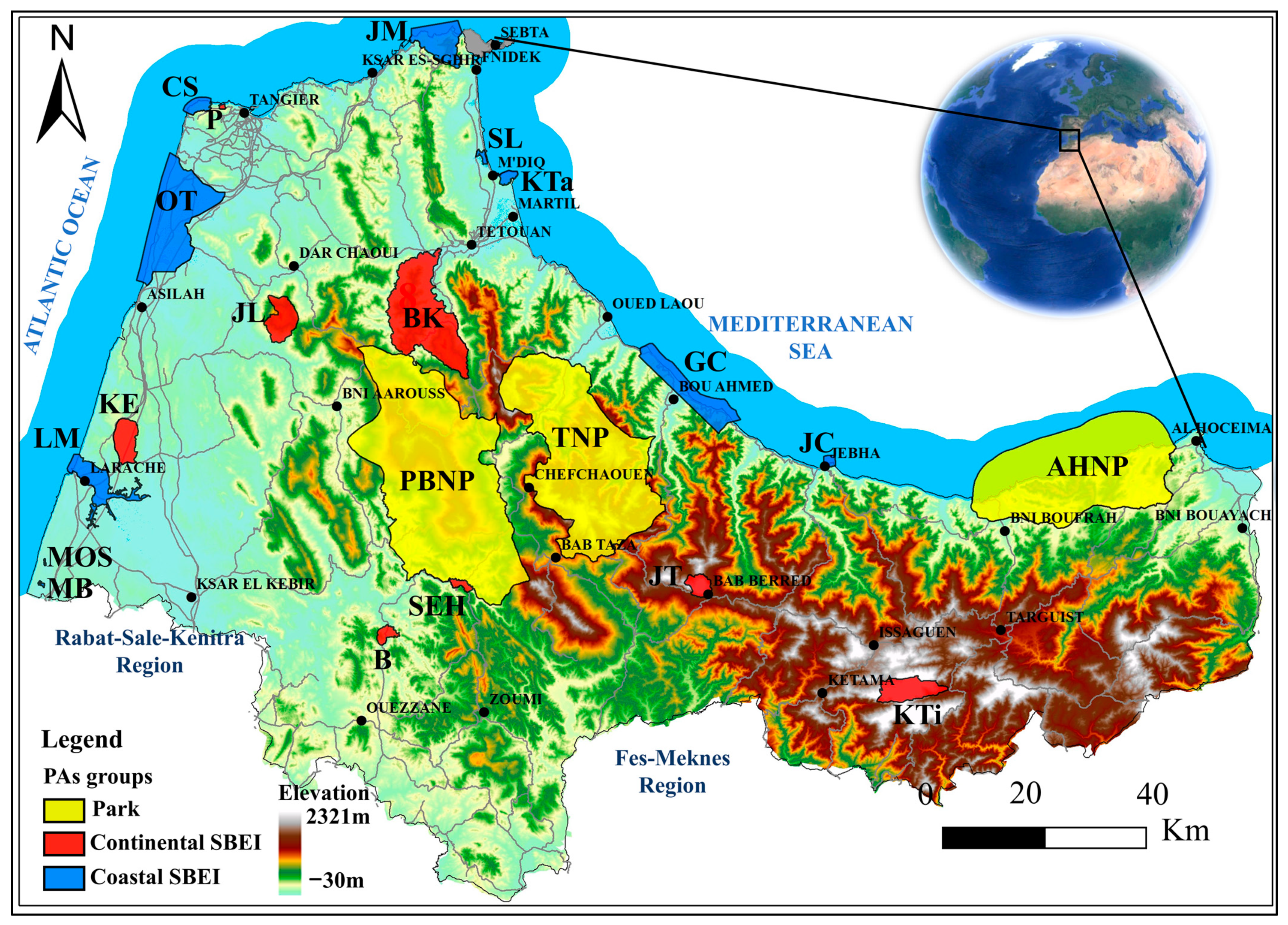
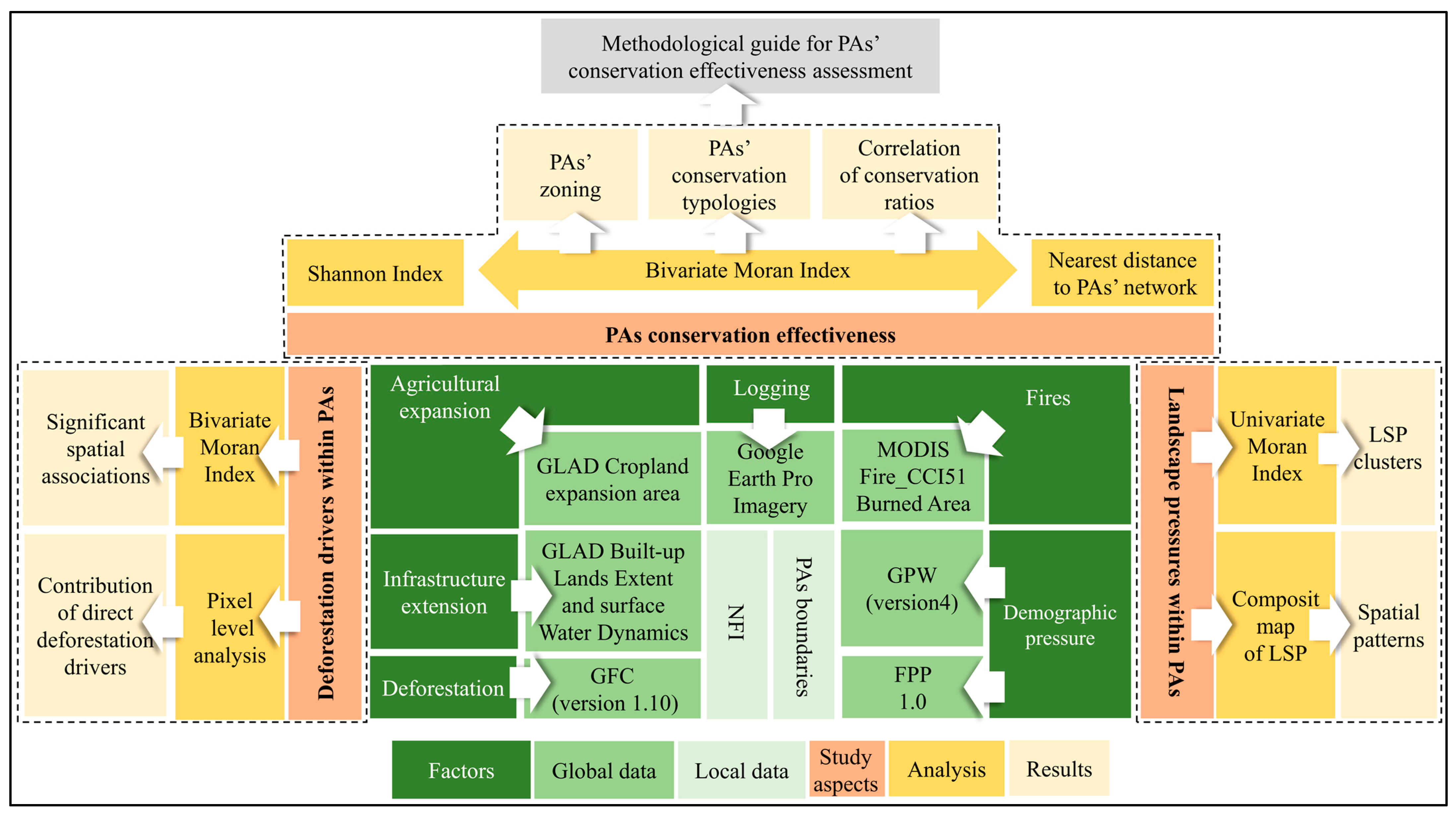
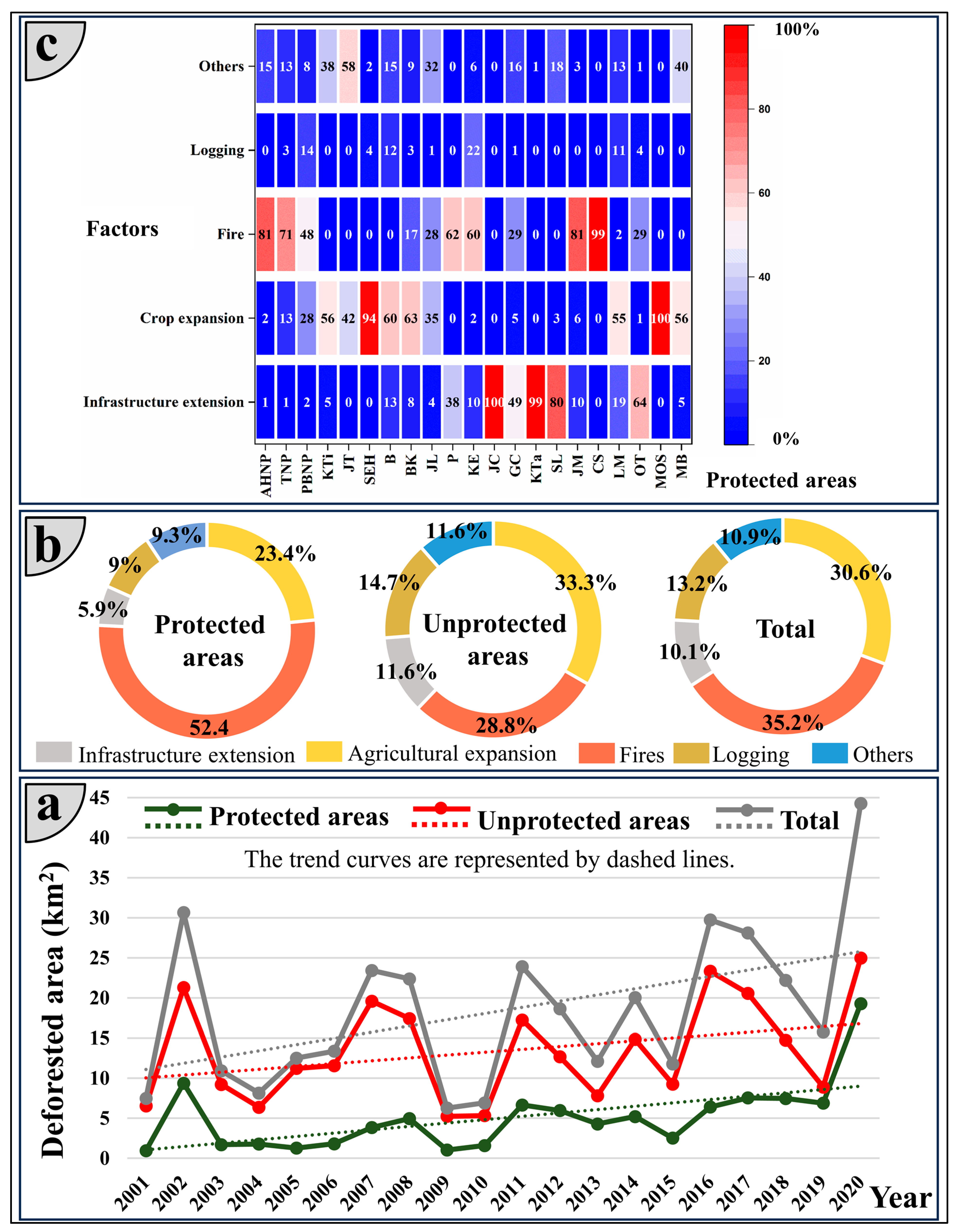
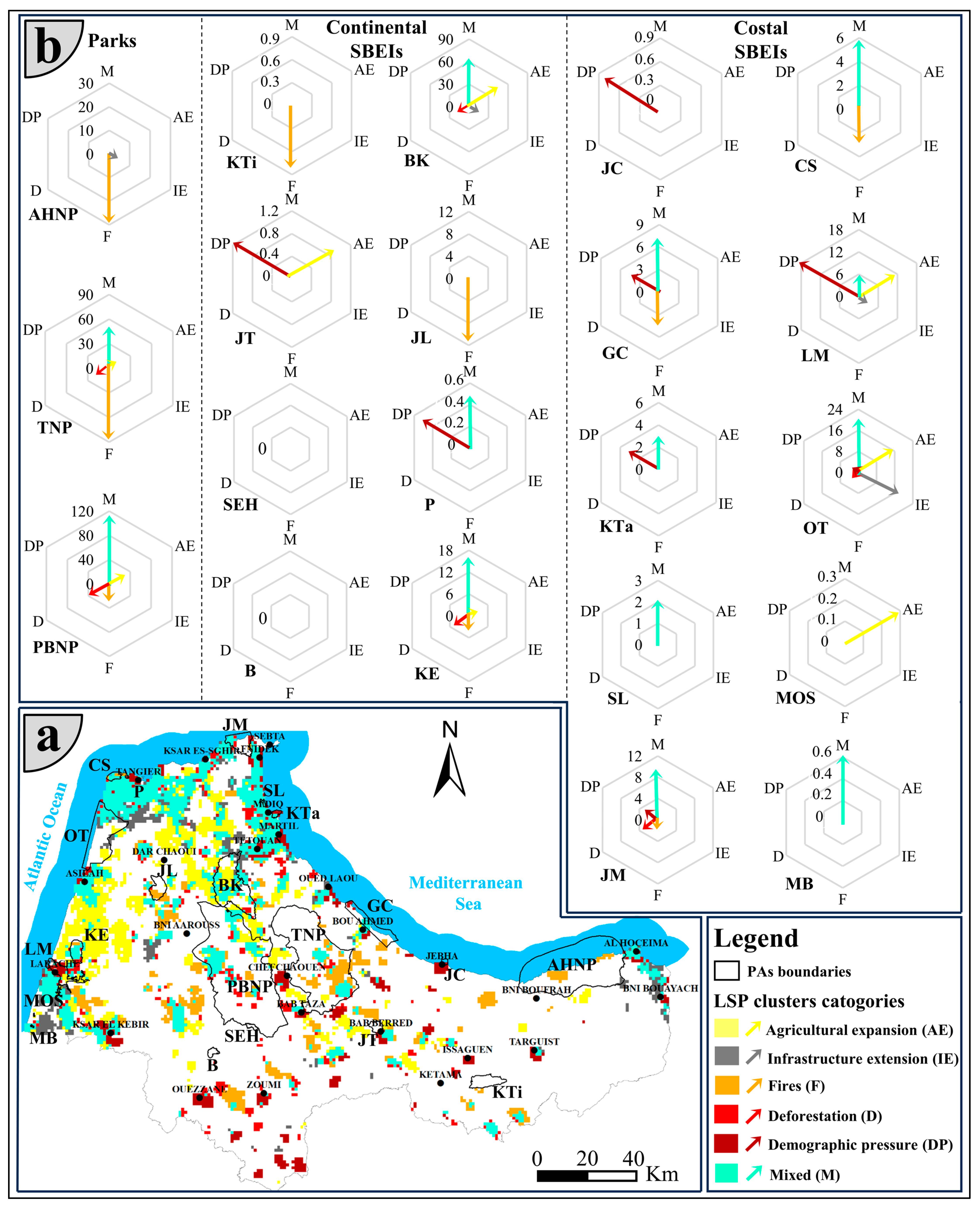
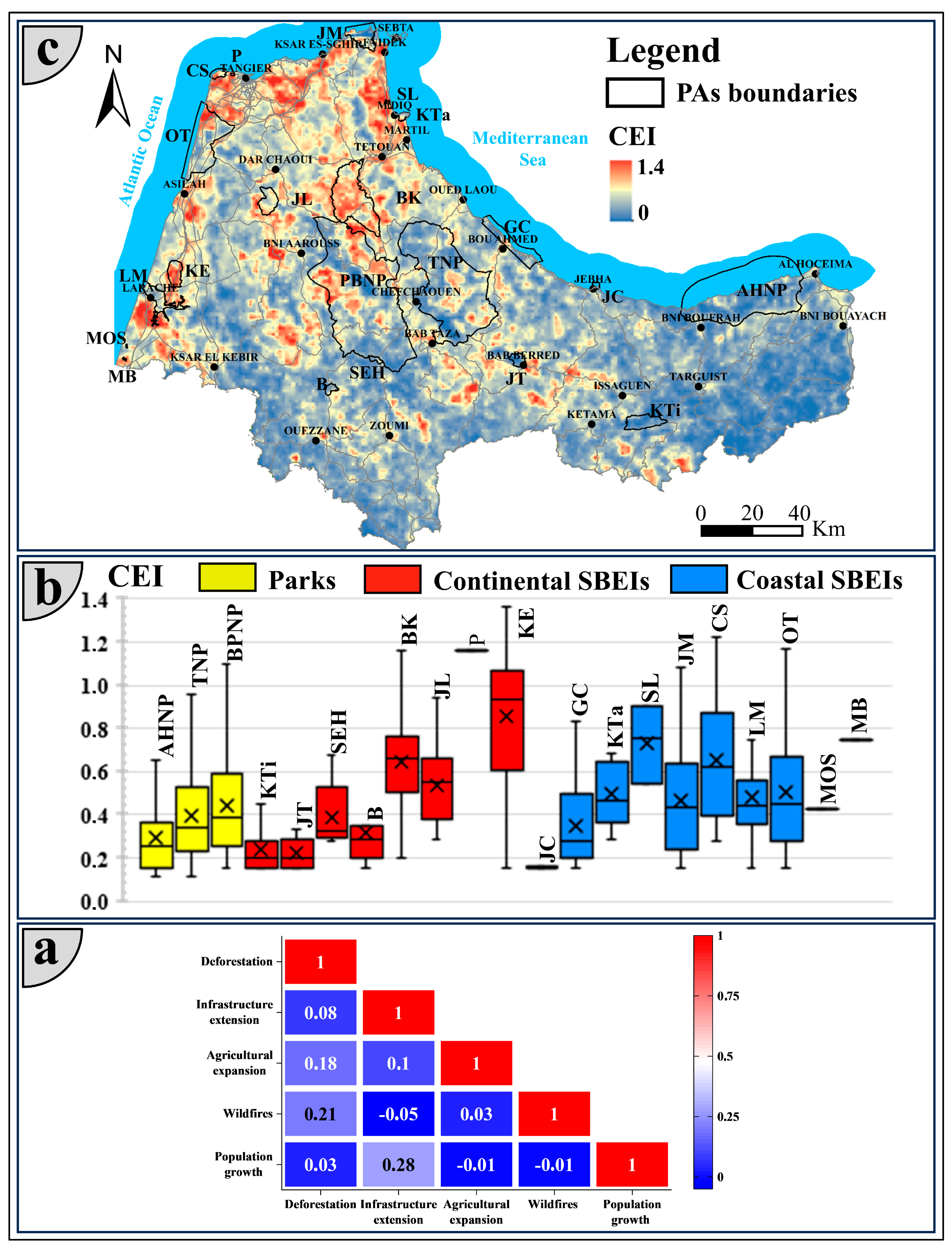

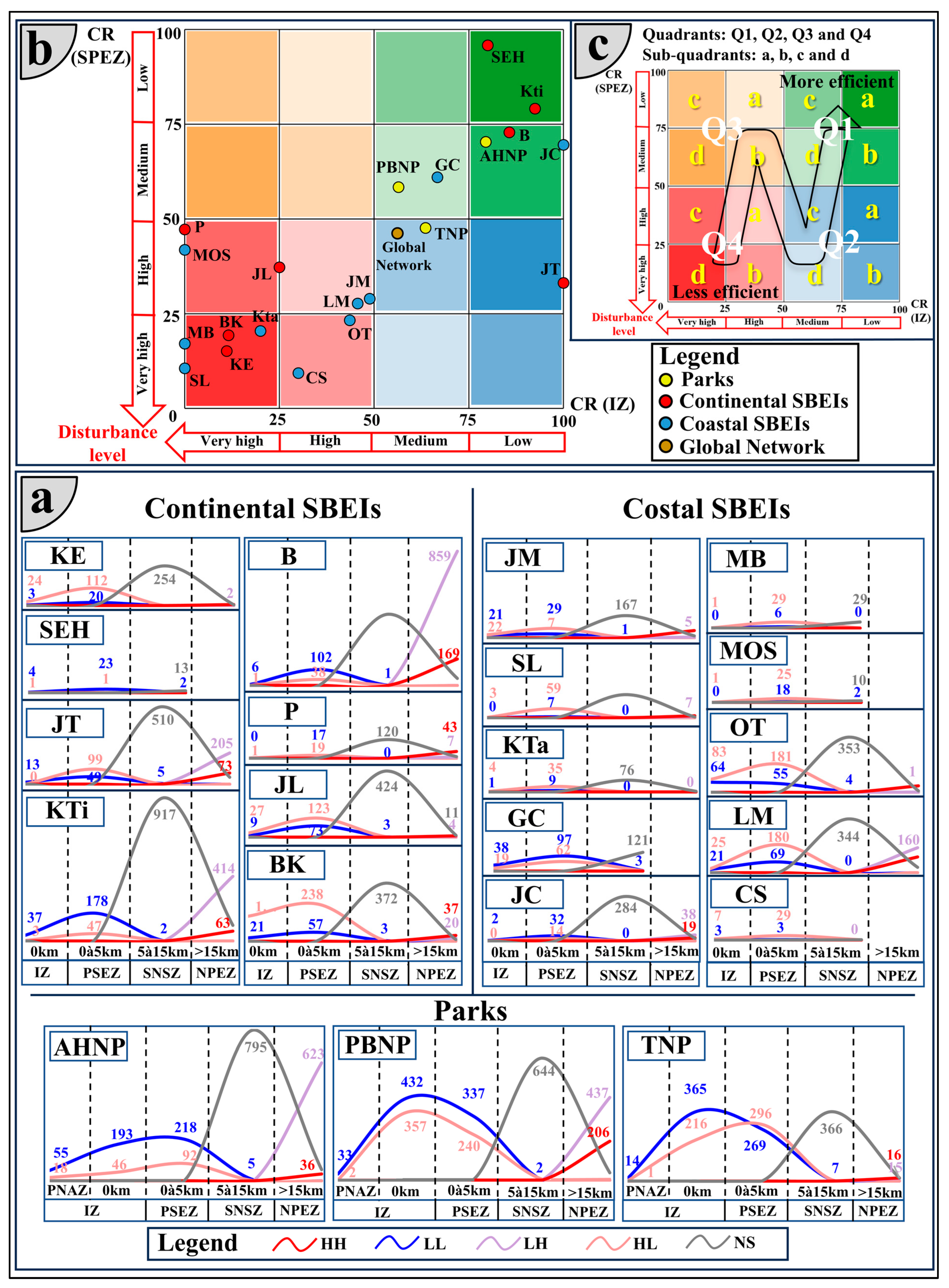
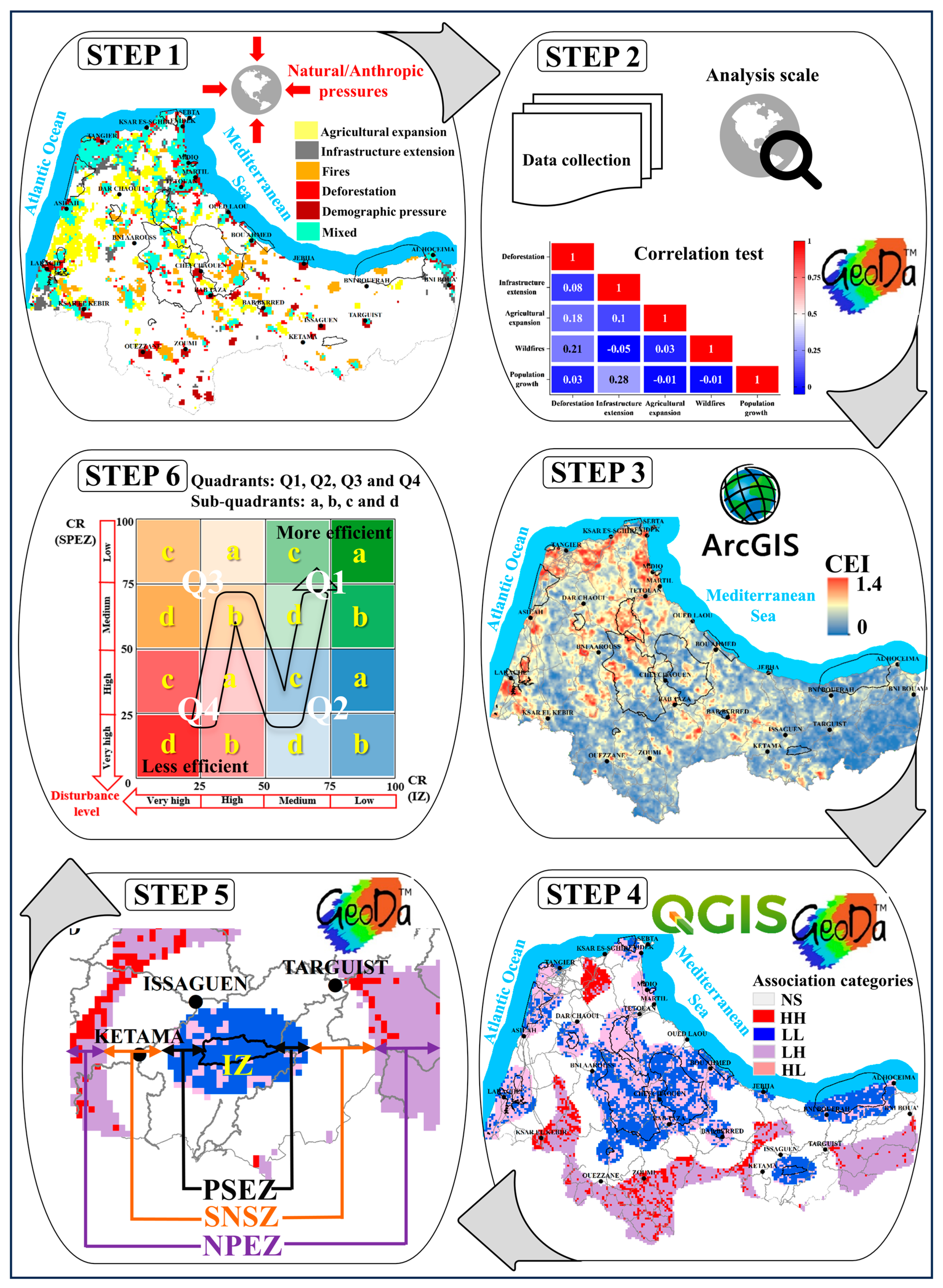
| Group | Number of PAs | Name | Code | Area (km2) * | Priority |
|---|---|---|---|---|---|
| Parks | 3 | Al Hoceima National Park | AHNP | 282 | 1 |
| Talassemtane National Park | TNP | 596 | 1 | ||
| Proposed Bouhachem Natural Park | PBNP | 818 | 1 | ||
| Continental SBEIs | 8 | Koudiat Tidighine | KTi | 39 | 2 |
| Jbel Tizirane | JT | 14 | 2 | ||
| Souk El Had | SEH | 5 | 3 | ||
| Brikcha | B | 8 | 2 | ||
| Ben Karrich | BK | 179 | 3 | ||
| Jbel Lahbib | JL | 33 | 3 | ||
| Perdicaris | P | 0.8 | 2 | ||
| Khmiss Essahel | KE | 28 | 3 | ||
| Coastal SBEIs | 10 | Jebha Circus | JC | 0.8 | 3 |
| Ghomara Coast | GC | 42 | 3 | ||
| Koudiat Taifour | KTa | 5 | 3 | ||
| Smir Lagoon | SL | 2 | 3 | ||
| Jbel Moussa | JM | 34 | 1 | ||
| Cape Spartel | CS | 7 | 3 | ||
| Larache Marshes | LM | 40 | 1 | ||
| Oued Tahadart | OT | 135 | 2 | ||
| Merja Oulad Skhar | MOS | 0.3 | 2 | ||
| Merja Bargha | MB | 0.6 | 2 | ||
| Total | 21 | 2269.5 |
| Category | Format | Name | Source | Resolution | DOI |
|---|---|---|---|---|---|
| Global data | Raster | Deforestation | GFC data (version 1.10) [35] | 30 m | https://doi.org/10.1126/science.1244693 |
| Infrastructure extension | GLAD Built-up Lands Extent and Change layer [28] | 30 m | https://doi.org/10.3389/frsen.2022.856903 | ||
| GLAD Global Surface Water Dynamics [36] | 30 m | https://doi.org/10.1016/j.rse.2020.111792 | |||
| Cropland expansion | GLAD Cropland Extent and Change [37] | 30 m | https://doi.org/10.1038/s43016-021-00429-z | ||
| Fires | MODIS Fire_CCI51 Burned Area Product [38] | 250 m | https://doi.org/10.5285/58F00D8814064B79A0C49662AD3AF537 | ||
| Demography | Gridded Population of the World, Version 4 (GPWv4) [39] | 1 km | https://doi.org/10.7927/H49C6VHW | ||
| Forest Proximate People (FPP) 1.0 dataset [40] | 100 m | https://doi.org/10.1016/j.oneear.2020.08.016 | |||
| Local data | Shapefile | National Forest Inventory (NFI) | [34] | -- | -- |
| PAs’ boundaries | [27] | -- | -- |
| Group | Code | Deforestation– Infrastructure Extension | Deforestation –Agricultural Expansion | Deforestation –Logging | Deforestation –Fires | Deforestation –Population Density Variation | Deforestation –FPP |
|---|---|---|---|---|---|---|---|
| Parks | AHNP | 0 | 0 | 0 | 11.48 | 0 | 0 |
| TNP | 0 | 4.78 | 8.61 | 93.75 | 0 | 0.48 | |
| PBNP | 0 | 119.34 | 57.16 | 74.86 | 0 | 0.48 | |
| Continental SBEIs | KTi | 0 | 0 | 0 | 0 | 0 | 0 |
| JT | 0 | 0 | 0 | 0 | 0 | 0.24 | |
| SEH | 0 | 0 | 0 | 0 | 0 | 0 | |
| B | 0 | 0 | 0 | 0 | 0 | 0 | |
| BK | 9.09 | 82.27 | 11.96 | 1.67 | 0 | 2.63 | |
| JL | 0 | 0.72 | 0 | 4.07 | 0 | 0 | |
| P | 0.48 | 0 | 0 | 0 | 0.48 | 0.48 | |
| KE | 0.96 | 0 | 17.22 | 18.65 | 0 | 2.39 | |
| Coastal SBEIs | JC | 0 | 0 | 0 | 0 | 0 | 0.48 |
| GC | 0 | 0 | 0 | 0 | 0 | 0 | |
| KTa | 2.63 | 0 | 0 | 0 | 2.63 | 2.63 | |
| SL | 2.15 | 0.72 | 0.72 | 0 | 2.15 | 2.15 | |
| JM | 3.11 | 0 | 0 | 9.81 | 0.48 | 0.96 | |
| CS | 0.24 | 1.67 | 3.59 | 3.59 | 0.72 | 1.67 | |
| LM | 3.35 | 4.07 | 2.15 | 0.72 | 0 | 3.11 | |
| OT | 18.18 | 4.78 | 0 | 9.09 | 1.67 | 5.5 | |
| MOS | 0 | 0 | 0 | 0 | 0 | 0 | |
| MB | 0 | 0.72 | 0 | 0 | 0 | 0 | |
| Total PAs | 40.18 | 219.07 | 101.4 | 227.68 | 8.13 | 23.2 | |
| Total TTA region | 487 | 929 | 504 | 784 | 174 | 298 | |
| % | 8.25 | 23.58 | 20.12 | 29.04 | 4.67 | 7.78 | |
| Group | PA’s Code | Number of Observations | Minimum | Maximum | Mean | Standard Deviation |
|---|---|---|---|---|---|---|
| Parks | AHNP | 312 | 0.11 | 0.76 | 0.29 | 0.14 |
| TNP | 596 | 0.11 | 1.13 | 0.40 | 0.21 | |
| PBNP | 824 | 0.15 | 1.32 | 0.44 | 0.24 | |
| Continental SBEIs | Kti | 40 | 0.15 | 0.48 | 0.24 | 0.10 |
| JT | 13 | 0.15 | 0.33 | 0.22 | 0.07 | |
| SEH | 5 | 0.28 | 0.67 | 0.39 | 0.16 | |
| B | 7 | 0.15 | 0.69 | 0.32 | 0.18 | |
| BK | 181 | 0.20 | 1.16 | 0.65 | 0.19 | |
| JL | 36 | 0.29 | 0.94 | 0.54 | 0.17 | |
| P | 1 | 1.16 | 1.16 | 1.16 | -- | |
| KE | 27 | 0,15 | 1.36 | 0.86 | 0.31 | |
| Coastal SBEIs | JC | 2 | 0.15 | 0.16 | 0.16 | 0.01 |
| GC | 57 | 0.15 | 0.83 | 0.35 | 0.18 | |
| KTa | 5 | 0.29 | 0.68 | 0.50 | 0.15 | |
| SL | 3 | 0.55 | 0.90 | 0.73 | 0.18 | |
| JM | 43 | 0.15 | 1.08 | 0.47 | 0.27 | |
| CS | 10 | 0.28 | 1.22 | 0.66 | 0.29 | |
| LM | 46 | 0.15 | 1.09 | 0.48 | 0.21 | |
| OT | 147 | 0.15 | 1.41 | 0.50 | 0.27 | |
| MOS | 1 | 0.43 | 0.43 | 0.43 | -- | |
| MB | 1 | 0.75 | 0.75 | 0.75 | -- | |
| Global network | 2357 | 0.11 | 1.41 | 0.43 | 0.24 | |
| PA’s Codes by Group | PA’s Number | Disturbance Levels | Quadrant | Sub- Quadrant | Conservation Effectiveness Typologies | |||
|---|---|---|---|---|---|---|---|---|
| Parks | Continental SBEIs | Coastal SBEIs | IZ | SPEZ | ||||
| -- | KE-BK | SL-MB-KTa | 5 | Very high | Very high | Q4 | d | Q4.d |
| -- | P-JL | MOS | 3 | Very high | High | Q4 | c | Q4.c |
| -- | -- | CS-OT | 2 | High | Very high | Q4 | b | Q4.b |
| -- | -- | LM-JM | 2 | High | High | Q4 | a | Q4.a |
| TNP | -- | -- | 1 | Moderate | High | Q2 | c | Q2.c |
| -- | JT | -- | 1 | Low | High | Q3 | a | Q2.a |
| PBNP | -- | GC | 2 | Moderate | Moderate | Q1 | d | Q1.d |
| AHNP | B | JC | 3 | Low | Moderate | Q1 | b | Q1.b |
| -- | SEH-Kti | -- | 2 | Low | Low | Q1 | a | Q1.a |
| Global network | Moderate | High | Q2 | c | Q2.c | |||
Disclaimer/Publisher’s Note: The statements, opinions and data contained in all publications are solely those of the individual author(s) and contributor(s) and not of MDPI and/or the editor(s). MDPI and/or the editor(s) disclaim responsibility for any injury to people or property resulting from any ideas, methods, instructions or products referred to in the content. |
© 2024 by the authors. Licensee MDPI, Basel, Switzerland. This article is an open access article distributed under the terms and conditions of the Creative Commons Attribution (CC BY) license (https://creativecommons.org/licenses/by/4.0/).
Share and Cite
Boubekraoui, H.; Attar, Z.; Maouni, Y.; Ghallab, A.; Saidi, R.; Maouni, A. Forest Loss Drivers and Landscape Pressures in a Northern Moroccan Protected Areas’ Network: Introducing a Novel Approach for Conservation Effectiveness Assessment. Conservation 2024, 4, 452-485. https://doi.org/10.3390/conservation4030029
Boubekraoui H, Attar Z, Maouni Y, Ghallab A, Saidi R, Maouni A. Forest Loss Drivers and Landscape Pressures in a Northern Moroccan Protected Areas’ Network: Introducing a Novel Approach for Conservation Effectiveness Assessment. Conservation. 2024; 4(3):452-485. https://doi.org/10.3390/conservation4030029
Chicago/Turabian StyleBoubekraoui, Hamid, Zineb Attar, Yazid Maouni, Abdelilah Ghallab, Rabah Saidi, and Abdelfettah Maouni. 2024. "Forest Loss Drivers and Landscape Pressures in a Northern Moroccan Protected Areas’ Network: Introducing a Novel Approach for Conservation Effectiveness Assessment" Conservation 4, no. 3: 452-485. https://doi.org/10.3390/conservation4030029
APA StyleBoubekraoui, H., Attar, Z., Maouni, Y., Ghallab, A., Saidi, R., & Maouni, A. (2024). Forest Loss Drivers and Landscape Pressures in a Northern Moroccan Protected Areas’ Network: Introducing a Novel Approach for Conservation Effectiveness Assessment. Conservation, 4(3), 452-485. https://doi.org/10.3390/conservation4030029









